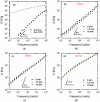Rheology⁻Microstructure Relationships in Melt-Processed Polylactide/Poly(vinylidene Fluoride) Blends
- PMID: 30513955
- PMCID: PMC6317166
- DOI: 10.3390/ma11122450
Rheology⁻Microstructure Relationships in Melt-Processed Polylactide/Poly(vinylidene Fluoride) Blends
Abstract
In this study, small amplitude oscillatory shear tests are applied to investigate the rheological responses of polylactide/poly(vinylidene fluoride) (PLA/PVDF) blends and to correlate their viscoelastic properties with the morphological evolutions during processing. Although the analysis of the elastic moduli reveals some changes as a function of blend composition and processing time, the weighted relaxation spectra are shown to be more useful in detecting changes. The analysis demonstrates that when PVDF, i.e., the more viscous phase, is the matrix, the blend relaxes cooperatively and only a single relaxation peak is observed. By contrast, blends with highly concentrated morphologies do not fully relax, showing instead an upward increasing trend at longer times. This outcome is attributed to the broad distribution of highly concentrated droplets with a high probability of droplet⁻droplet contacts. Dynamic mechanical analysis (DMA) reveals that crystalline segmental motions attributed to the α-relaxation of PVDF at around 100 °C are restricted by the highly concentrated morphology of the 50/50 PLA/PVDF blend processed for 10 min. Relaxation analyses of the blends via dynamic oscillatory shear tests and DMA are shown to be powerful tools for investigating small microstructural changes in immiscible polymer blends.
Keywords: PLA/PVDF blend; processing-driven morphology; rheology.
Conflict of interest statement
The authors declare no conflict of interest. The funders had no role in the design of the study; in the collection, analyses, or interpretation of data; in the writing of the manuscript, and in the decision to publish the results.
Figures











References
-
- Paul D., Walsh D., Higgins J. Polymer Blends and Mixtures. Springer; Berlin, Germany: 1985.
-
- Salehiyan R., Song H.Y., Hyun K. Nonlinear behavior of PP/PS blends with and without clay under large amplitude oscillatory shear (LAOS) flow. Korea. Aust. Rheol. J. 2015;27:95–103. doi: 10.1007/s13367-015-0010-3. - DOI
-
- Ziegler V., Wolf B.A. Viscosity and morphology of the two-phase system PDMS/P (DMS-ran-MPS) J. Rheol. 1999;43:1033–1045. doi: 10.1122/1.551011. - DOI
-
- Jafari S.-H., Hesabi M.-N., Khonakdar H.A., Asl-Rahimi M. Correlation of rheology and morphology and estimation of interfacial tension of immiscible COC/EVA blends. J. Polym. Res. 2011;18:821–831. doi: 10.1007/s10965-010-9479-0. - DOI
-
- Utracki L. On the viscosity-concentration dependence of immiscible polymer blends. J. Rheol. 1991;35:1615–1637. doi: 10.1122/1.550248. - DOI
Grants and funding
LinkOut - more resources
Full Text Sources
Molecular Biology Databases

